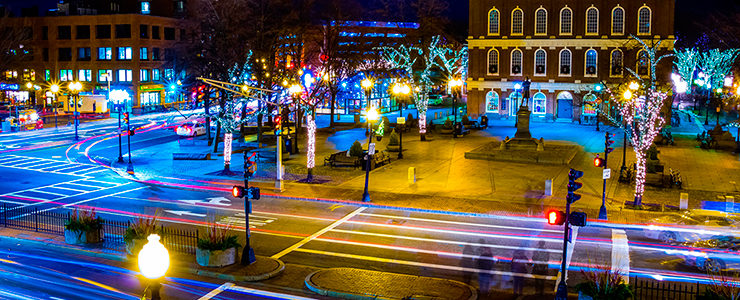Outdoor Street Lighting, Glare, and Circadian Rhythm Disturbance
I have been a light pollution advocate for many years. Certainly 30 years ago I was most interested in the sky glow that affects our view of the starry night, and though that remains a major concern, there are now many medical, safety, and environmental concerns that are paramount. On an energy committee in my town, I was able to show that poorly lit intersections with severe glare by unshielded lighting had the highest accident rate. Further review of published studies has shown that as the eye ages, it becomes much more sensitive to disability glare, impairing safe driving. That led to my 2009 resolution, which suggested that all streetlights be properly shielded to prevent such glare, making both the streets and the elderly driving in the evening safer. This resolution is still cited by lighting companies.
In 2012, knowing the research activities of many scientists from around world on the effects of nighttime lighting on human physiology, I invited four prominent researchers to help me write a Council on Science and Public Health (CSAPH) report, “Light Pollution: Adverse Health Effects of Nighttime Lighting.” This 27-page report with 134 peer-reviewed references highlighted the adverse health effects of circadian rhythm disturbance. Suppressing melatonin production through excessive night lighting, especially blue light, leads to myriad deleterious health effects. The most stunning is an increase in certain endocrine-related carcinomas. It is now well known that circadian disturbance causes a 20–30% increase in breast cancer rates, and a similar increase in prostate cancers. Indeed, this past year (2017) the Nobel Prize in medicine was awarded to Young, Rosbach, and Hall, because they elucidated the biochemical pathways that lead to increased cancer by melatonin suppression. In addition, obesity, diabetes, metabolism issues, and immune system are all affected by melatonin suppression. The World Health Organization has even listed shift workers, who have repeated melatonin suppression as a “known Carcinogen, level 2.”
After the 2012 report came out, there was some pushback from the lighting industry. However, in 2014 General Electric wrote its own white paper on this subject, and agreed not only with the AMA report, but also liberally quoted from our report. The GE report stated that corporate policy would change to take note of melatonin production in its lighting policies and products. Shortly after that, Apple developed a blue reduction in its phones and computers for late night. Many other companies have since adopted this practice. Again, with the Nobel Prize, and over 1,000 peer-reviewed papers, this is now settled science! The last section of the 2012 report also raised the alarm that excessive outdoor blue light was also causing environmental harm, as all living creatures have a circadian rhythm — even a one-celled life!
NEW: JAMA article on adverse human health effects of light pollution published November 2024. CME credit available after reading:
https://journalofethics.ama-assn.org/article/were-all-healthier-under-starry-sky/2024-10
NEW 2022: UN report on light pollution completed and submitted.
final UN submission document 2022, I am very happy to have been part of this for the past 2 years, and also that it mirrors AMA policy on human effects of light pollution, we did it first!
https://zenodo.org/record/5874725#.YhgMzujMIpc
NEW! PBS Nova article on light pollution, I was consulted on and quoted:
https://www.pbs.org/wgbh/nova/article/light-pollution-led-nantucket-solutions/
LED Lighting
In the ensuing years the lighting industry has developed LED lighting and plans to replace all outdoor lighting with LEDs over the next 10 years. Given my 2012 paper, and many reports of environmental damage by excessive blue, I was able to convince the CSAPH to let me lead on one more report, “Human and Environmental Effects of Light Emitting Diode (LED) Community Lighting,” which was adopted at the 2016 AMA annual meeting by the HOD. This particular report hit a nerve with the lighting industry. However, the report actually says that we should replace outdoor lighting with LED lights to save energy, and we should shield all streetlights to prevent glare — that was widely accepted. The last resolve stating that blue light should be limited in outdoor lighting and streetlights should use 3000K or lower color temperature led to severe consternation in the lighting industry. The issue was that many companies were trying to sell 4000K lighting, as those were the first type of LEDs manufactured. They had inventory already made. LED lights use a blue LED and coat it to absorb the blue and re-emit at lower “warmer” color temperature (e.g., 3000K). However, 4000K lighting is 30–34% blue light. The 2012 paper and thousands of studies have already shown this is bad for humans and the environment in general. The AMA report suggested no higher than 3000K; nowadays, there is good 2700K lighting, even 2400K lighting, and the trend is lower. There is evidence that high blue leads to severe insect, bird, and mammalian effects in nature. It has even been shown to effect salmon runs and plankton!
When the AMA report came out, it was hailed by researchers, and many cities paused their efforts to study it closely. They came to the same conclusion, and demanded warmer 3000K — or even 2700K — lighting. Many companies changed their products and are now thriving, while others are still fighting. To date, most large cities have now adopted the AMA recommendation and use “AMA Compliant Lighting”! New York, Chicago, Tucson, Phoenix, Los Angeles, San Francisco, San Diego, Georgia, Toronto, Montreal, and many others have changed their lighting plans and demand 3000K or lower. This is helped by the fact that wherever 4000K lighting was installed, citizens immediately complained about the harsh glare of bluish light. Some cities, such as Monterey and Davis in California, even sued their cities and demanded a switch to 3000K or lower.
I consider this a huge win, and it shows the power and influence the AMA can exert when we use science and recommendations for the common good. The 2016 report has in the words of many lighting engineers “revolutionized” the lighting industry. This would not have occurred without the AMA publishing this report and cities looking at it and demanding “AMA Compliant Lighting.”
New: JAMA article on human effects of Light Pollution, November 2024: Link below: AMA members can obtain 1 CME after reading and answering 5 questions
https://journalofethics.ama-assn.org/article/were-all-healthier-under-starry-sky/2024-10
The IES (illuminating Society of engineers) who make the guidelines many cities use to guide street lighting, has revised their recommendations. They now parrot the 2016 CSPH report. This is the group that was ‘demanding” that the AMA delete its recommendations on street lighting after our CSPH 2016 report, objecting to the recommendation that cities use no higher than 3000K lighting and lashed out at the AMA for daring to tell them their lighting recommendations were wrong. Based on our scientific data the AMA stood by its position
Then last year I was invited to speak to their roads comm in Quebec, and debated their chair at a lighting meeting in California. They stated they would take my recommendations and talk under advisement.. It appears that without admitting they were wrong they have quietly changed their tune…. Street lighting will now hopefully follow AMA guidance everywhere.
See below:
The Illuminating Engineering Society has published its new comprehensive lighting recommendation (RP-8-18). Their recommendations are historically widely used as the lighting bible for cities. RP-8-18 recently won an award at LIGHTFAIR International for its new thinking on lighting in the age of LED. It is a must have for Public Works and area developers. There are now many recommendations and discussions included that highlight the concerns of the American Medical Association and the International Dark-Sky Association. Their concerns are seen as being in line with lighting that also provides the best visibility.
Here are highlights:
1. Do not exceed the recommended light levels. Excessive light can create glare that can reduce visibility to the point where the visibility is worse than using no lighting at all plus headlights. (This is almost verbatim from the AMA 2016 report concerning visibility under higher glare LED street lights.)
2. For decorative lighting, use only shielded versions due to glare and light trespass problems with unshielded models.
3. Design for the impact of lighting on human health, animals, and the night sky. To minimize skyglow, choose longer wavelength LED color that scatters less in the atmosphere (lower blue and warmer white or amber in color), and avoid over lighting to minimize the amount of light reflected from the surface below. Bluer LEDs also disrupt circadian function by suppressing melatonin which in turn disrupts sleep and allows some hormone based cancers to grow faster at night.
4. Shorter wavelength light does allow better color rendition and peripheral acuity, but warm white provides very good visibility on major streets while reducing perceived glare and lower traffic areas do not need maximum brightness as headlights combined with less bright street lights work at slower speed limits.
5. Luminance (reflected light off the street) rather than illuminance (how much light is hitting the street) is the recommended calculation method for most roadway lighting and the new standard includes a calculation for veiling luminance. RP-8-14 for roadway lighting was incorporated into RP-8-18.
REFERENCE:
2012 paper describing human health and environmental effects of poor lighting
AMA Health Effects Light at Night
CSPH report advising municipalities to limit all LED lighting to below 3000K
American Journal of Preventive Medicine, 2013 article on LED lighting health effects
GE paper agreeing with AMA position
GE Lighting And Sleep Whitepaper (PDF)
Article form myself and Richard Stevens on human health harm
American Journal of Preventive Medicine (PDF)
Article on breast cancer risk from melatonin suppression
Great article from National Geographic on environmental damage of bad lighting
US skyscrapers kill 600 million — yes, million — birds every year
https://www.cnn.com/2019/04/08
Impressive article from Nature Magazine Jan 2018 of environmental damage
https://www.nature.com/articles/d41586-018-00665-7
LED lights damage eyes and disturb sleep, European health authority warns
A French health authority warned of the dangers of blue light, stating this wavelength can damage the eye’s retina while also disturbing our biological and sleep rhythms.
Read in CNN: https://apple.news/

